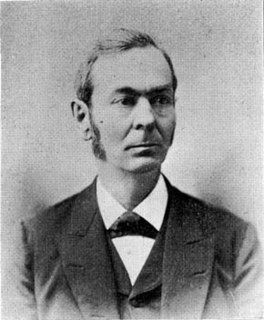Related Research Articles

Petter Adolf Karsten was a Finnish mycologist, the foremost expert on the fungi of Finland in his day, and known in consequence as the "father of Finnish mycology".

Kuehneromyces is a genus of agaric fungi in the family Strophariaceae. The genus was circumscribed by mycologists Rolf Singer and Alexander H. Smith in 1946.

Charles Horton Peck was an American mycologist of the 19th and early 20th centuries. He was the New York State Botanist from 1867 to 1915, a period in which he described over 2,700 species of North American fungi.
Howard Elson Bigelow was an American mycologist, born in 1923 in Greenfield, Massachusetts, and died in 1987. He studied at Oberlin College from 1941 to 1943. He left college to fight in the American army. He returned to Oberlin after the war and obtained his Bachelor of Arts in 1949 and his Master of Arts in 1951. He studied botany at the University of Michigan under the guidance of Alexander Hanchett Smith (1904–1986) and received his doctorate in 1956. He was wed to mycologist Margaret Elizabeth Barr-Bigelow in 1956. Bigelow and his wife worked for University of Massachusetts from 1957 to his death. He is the author of works on the fungi of the genus Clitocybe and the family Tricholomataceae.

Genea is a genus of truffle-like fungi in the family Pyronemataceae. There are about 32 species in the genus that occur in North America and Europe. The genus was circumscribed by Italian mycologist Carlo Vittadini in 1831.
Lohwagia is a genus of fungi in the family Phyllachoraceae. The genus was described by Austrian-Czech mycologist Franz Petrak in 1942. Lohwagia contains three species: the type L. intermedia, L. kessleriana and L. verruciformis.
Neopeckia is a genus of fungi in the class Dothideomycetes. The relationship of this taxon to other taxa within the class is unknown.
Diehliomyces is a genus of fungi in the Ascomycota phylum. The relationship of this taxon to other taxa within the phylum is unknown, and it has not yet been placed with certainty into any class, order, or family. This is a monotypic genus, containing the single species Diehliomyces microsporus.
Dennisiomyces is a genus of fungi in the family Tricholomataceae. Described by mycologist Rolf Singer in 1955, the genus contains five species found in South America.

Fayodia is a genus of fungi in the family Tricholomataceae. It was first described by Robert Kühner in Bull. Bi-Mens. Soc. Linn. Lyon Vol.9 on page 68 in 1930, and the specific epithet honors the Swiss mycologist Victor Fayod (1860–1900). The widespread genus contains 10 species, mostly in the northern temperate regions.
Haasiella is a fungal genus in the family Hygrophoraceae. It is a monotypic genus that contains only the species Haasiella splendidissima. Haasiella venustissima, formerly considered to be a distinct species based on its one and two-spored basidia, was found by a DNA study to be synonymous with H. splendidissima. H. splendidissima is only known from Europe and is saprotrophic on wood. Haasiella was described as a new genus in 1966 by Czech mycologists František Kotlaba and Zdeněk Pouzar. It is most closely related to the genus Hygrophorus.

The Mixiomycetes are a class of fungi in the Pucciniomycotina subdivision of the Basidiomycota. The class contains a single order, the Mixiales, which in turn contains a single family, the Mixiaceae that circumscribes the monotypic genus Mixia. Only one species has been described to date, Mixia osmundae; this species was originally named Taphrina osmundae by Japanese mycologist Toji Nishida in 1911. It is characterized by having multinucleate hyphae, and by producing multiple spores on sporogenous cells.

John-Axel Nannfeldt, born 18 January 1904 in Trelleborg and deceased 4 November 1985 in Uppsala, was a Swedish botanist and mycologist.

Job Bicknell Ellis was a pioneering North American mycologist known for his study of the Ascomycetes, especially the grouping of fungi called the Pyrenomycetes. Born and raised in New York, he worked as a teacher and farmer before developing an interest in mycology. He collected specimens extensively, and together with his wife, prepared 200,000 sets of dried fungal samples that were sent out to subscribers in series between 1878 and 1894. Together with colleagues William A. Kellerman and Benjamin Matlack Everhart, he founded the Journal of Mycology in 1885, forerunner to the modern journal Mycologia. He described over 4000 species of fungi, and his collection of over 100,000 specimens is currently housed at the herbarium of the New York Botanical Gardens. Ellis had over 100 taxa of fungi named in his honor.
Cunninghammyces is a genus of corticioid fungi in the family Cyphellaceae. The genus, described by Joost Stalpers in 1985, contains two species known from New Zealand and Réunion.
Benjamin Matlack Everhart was a United States mycologist.
Margaret Elizabeth Barr Bigelow (1923-2008) was a Canadian mycologist known for her contributions to the Ascomycetes fungi.
Fischerula is a genus of two truffle-like fungi in the family Morchellaceae. First described from central Italy by Oreste Mattirolo in 1928, the genus name honors Swiss mycologist Eduard Fischer. The type species Fischerula macrospora is known only from Italy, while Fischerula subcaulis is found in coniferous and mixed forests of Oregon and Washington.
Gustav Heinrich Otth was a Swiss mycologist and military officer. He was the brother of naturalist Carl Adolf Otth (1803-1839).
Libertella is a genus of fungi belonging to the family Diatrypaceae.
References
- ↑ Barr ME. (1978). "The Diaporthales in North America: with emphasis on Gnomonia and its segregates". Mycologia Memoirs. Lehre, Germany: J. Cramer. 7: 164. ISBN 3768211894.
- ↑ Burkhardt, Lotte (2022). Eine Enzyklopädie zu eponymischen Pflanzennamen [Encyclopedia of eponymic plant names](pdf) (in German). Berlin: Botanic Garden and Botanical Museum, Freie Universität Berlin. doi:10.3372/epolist2022. ISBN 978-3-946292-41-8 . Retrieved January 27, 2022.